DevOps teams need deep visibility into their software, from frontend performance metrics to backend infrastructure health. Sentry has gained popularity for its robust error tracking and real-time notifications, but does it provide the complete observability modern teams require?
In this article, we will dissect Sentry's observability offerings, highlight its strengths and limitations, and explore how to augment Sentry with complementary solutions for a more comprehensive DevOps toolchain.
Quick Guide: Sentry Observability at a Glance
- Sentry's Core Strength
- Excellent for application-level error tracking, debugging, and performance monitoring.
- Provides rich context with stack traces, user sessions, and release tracking.
- Major Gaps in Full-Stack Observability
- Limited capabilities for infrastructure monitoring, log aggregation, and network insights.
- Distributed tracing support is present but not as robust for large microservice landscapes.
- Combining Sentry with Other Tools
- Integrate with log management (e.g., ELK) and metrics tools (e.g., Prometheus, Grafana) to gain deeper visibility.
- For complete end-to-end distributed tracing, consider specialized solutions or open-source platforms like SigNoz.
- Final Verdict
- Sentry excels at error tracking and application monitoring but isn't a complete observability solution.
- For comprehensive DevOps observability, combine Sentry with specialized tools for infrastructure monitoring, log management, and advanced distributed tracing.
What is Sentry Observability and How Does It Work?
Sentry is an application monitoring platform that focuses on error reporting and performance monitoring. It captures and aggregates exceptions, stack traces, and user feedback to streamline debugging and root-cause analysis.
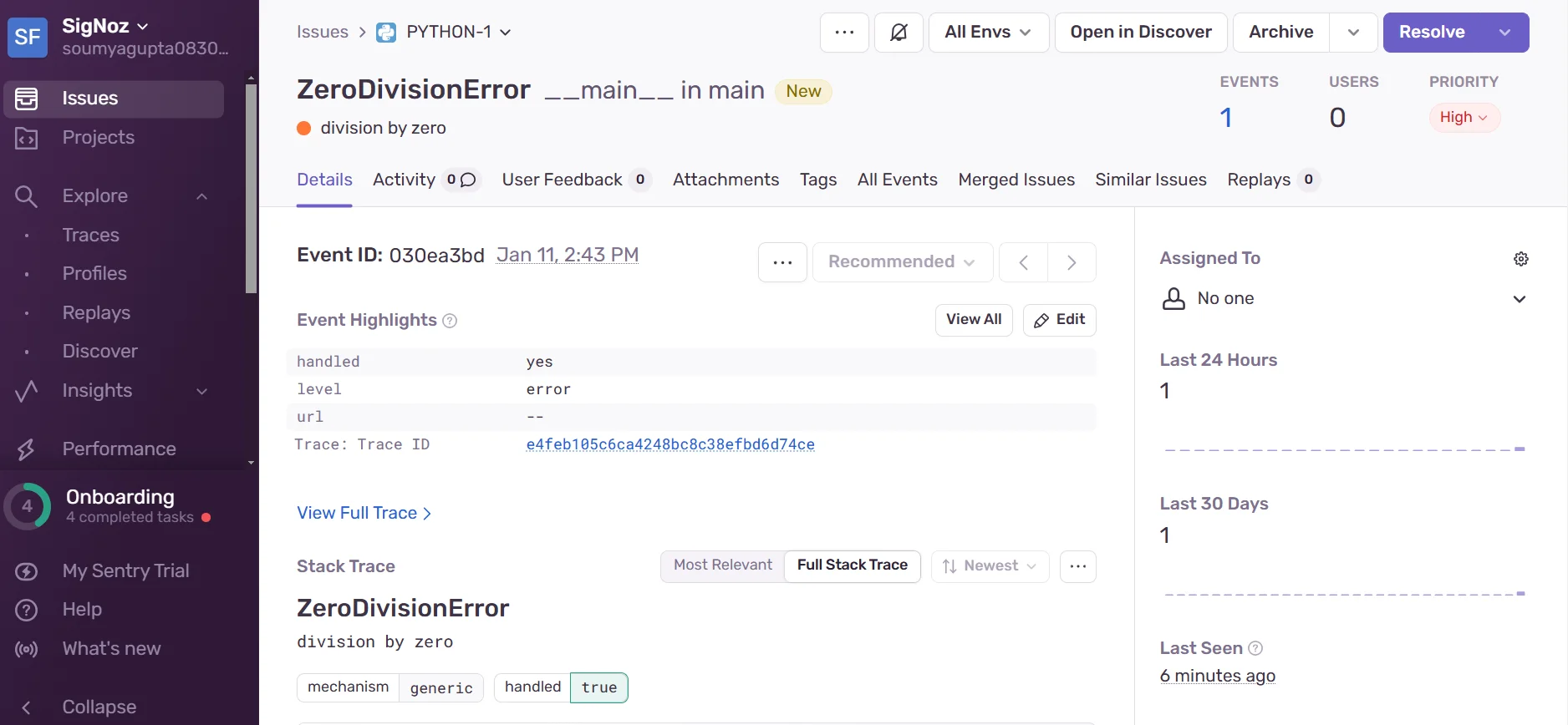
Core Features of Sentry
Sentry is best known for real-time error tracking and application performance monitoring (APM). Its core features include:
- Error and Exception Monitoring: Catches application errors in real-time, intelligently grouping recurring issues while providing stack traces, breadcrumbs, and contextual data.
- Performance Tracing: Monitors transaction performance with distributed tracing capabilities, measuring request latency and identifying bottlenecks.
- Release Tracking: Integrates with version control and CI/CD systems to track which errors were introduced in specific deployments.
- Rich Integration Ecosystem: Supports numerous languages and frameworks while connecting to collaboration tools (Slack, Teams), alerting systems (PagerDuty), and issue trackers (Jira).
- User Experience Monitoring: Provides Real User Monitoring (RUM) with Session Replay capabilities.
- Custom Metrics: Allows tracking of application-specific numeric values that can be correlated with transaction traces.
In summary, Sentry’s feature set centers on observing application behavior – primarily errors and performance within the code – and integrating that information into the developer workflow. It shines in telling developers what went wrong in the code and where, which is invaluable during continuous delivery.
Key Components of Sentry's Observability Offering
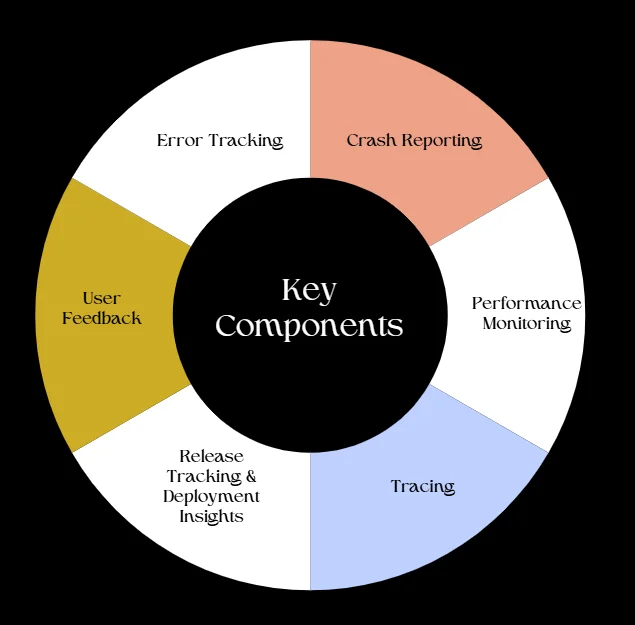
Error Tracking
Sentry provides robust error tracking and crash reporting by integrating with your application's runtime environment through its SDKs. Once integrated, Sentry automatically captures unhandled exceptions and errors, sending detailed reports in real-time.
To help developers quickly identify, categorize, and resolve issues, Sentry offers the following capabilities:
- Captures exceptions in real-time
Sentry ensures that critical errors don't go unnoticed by capturing exceptions as they occur. The SDK provides methods to explicitly report errors, log events, and add custom messages.
def main():
try:
# Trigger an error intentionally
1 / 0
except Exception as e:
sentry_sdk.capture_exception(e)
Run the script with:
python app.py
This will send the captured exception to Sentry.
Next, navigate to Sentry’s dashboard to view the captured issue.

Click on the error to explore detailed insights, including stack traces, affected environments, and additional debugging information.

- Groups similar errors to avoid alert fatigue
Sentry prevents alert fatigue by intelligently grouping similar errors using fingerprints. A fingerprint is a way to uniquely identify an event, and all events have one. Events with the same fingerprint are grouped together into an issue.

You can set up custom grouping rules under [Project] > Settings > Issue Grouping > Fingerprint Rules. Sentry reviews all stack trace frames and applies the fingerprint if an event matches the rule's conditions.
- Custom Tagging
Sentry allows you to tag events with feature flag data for better debugging and performance monitoring. Feature flags are a technique used in software development to enable or disable specific features of an application at runtime without changing the code. They provide flexibility in controlling the availability of features for specific users or environments, often without requiring a redeployment.
By tagging events with feature flags, you can easily isolate and analyze issues tied to specific feature configurations.
Practical Scenario Example: Let’s say you’re rolling out a new feature (e.g., a widget) and you want to track its performance, or any errors associated with it. You can tag events with the status of the show_widget feature flag. Then, when an issue occurs, you can easily filter to see whether users who encountered the issue had the widget enabled or not.
from sentry_sdk import start_transaction, capture_exception
from sentry_sdk import set_tag
sentry_sdk.init(
...
profiles_sample_rate=1.0, # Enable profiling
)
def set_feature_flag_tag(user):
# Tagging the 'show_widget' feature flag to track its state
show_widget = user.get("showWidget", False)
set_tag("show_widget", show_widget)
# Simulating a user and checking their feature flag status
user = {"id": 123, "username": "test_user", "showWidget": True}
set_feature_flag_tag(user)
# Start a transaction for performance monitoring
with start_transaction(op="task", name="feature-check"):
print("Performing some task..."
The set_feature_flag_tag() function assigns a Sentry tag for the show_widget feature flag, indicating whether the user has it enabled (True) or not (False). Meanwhile, start_transaction initiates a new transaction, representing a unit of work in the application. It takes an op (operation type) and a name ("feature-check") to provide context. Using the with statement ensures the transaction starts when the block begins and ends automatically when it finishes.
You can filter issues or transactions based on tags. For example, you can filter issues to see only those that were triggered by users with the widget enabled (show_widget = True)
Let’s head to sentry’s dashboard in trace view
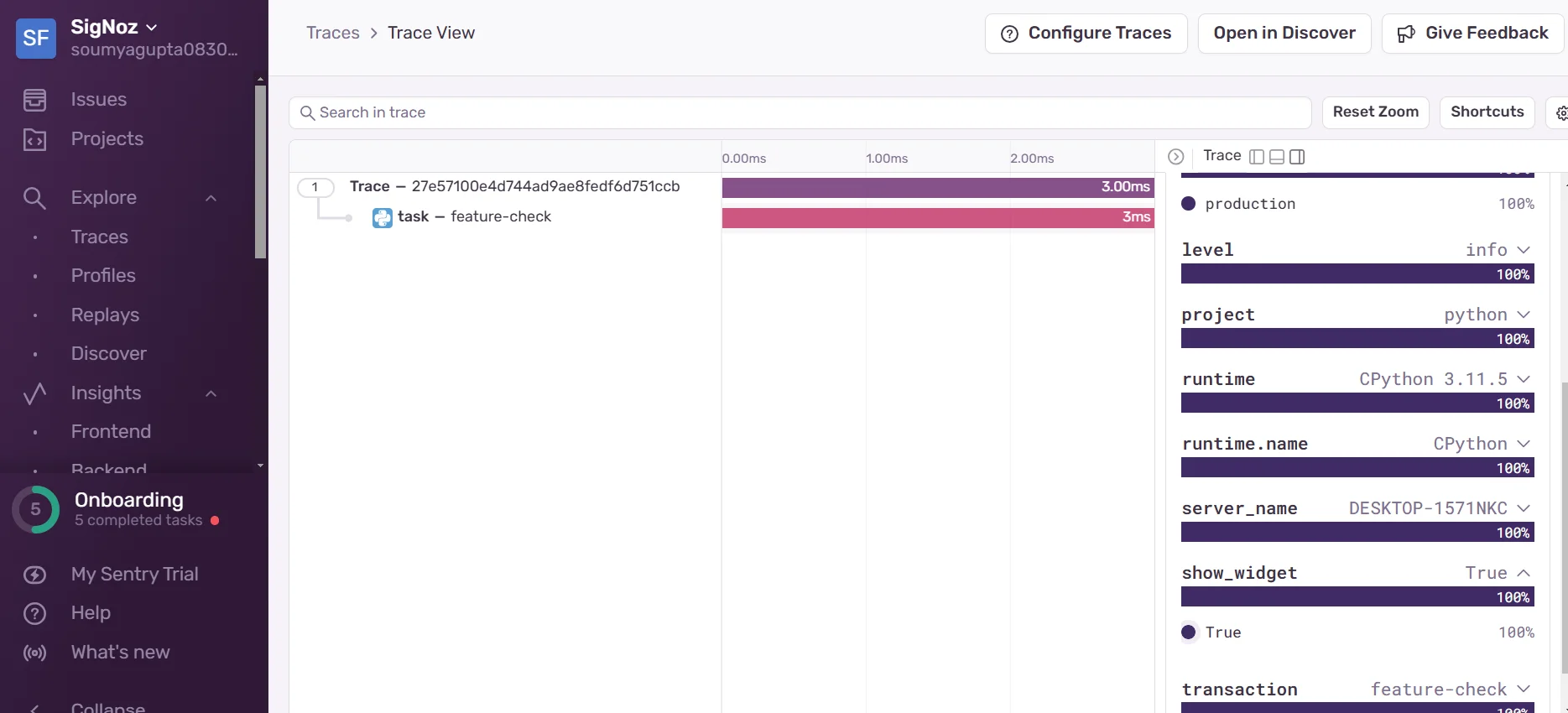
Similarly, you can also view it on the Transactions Summary page
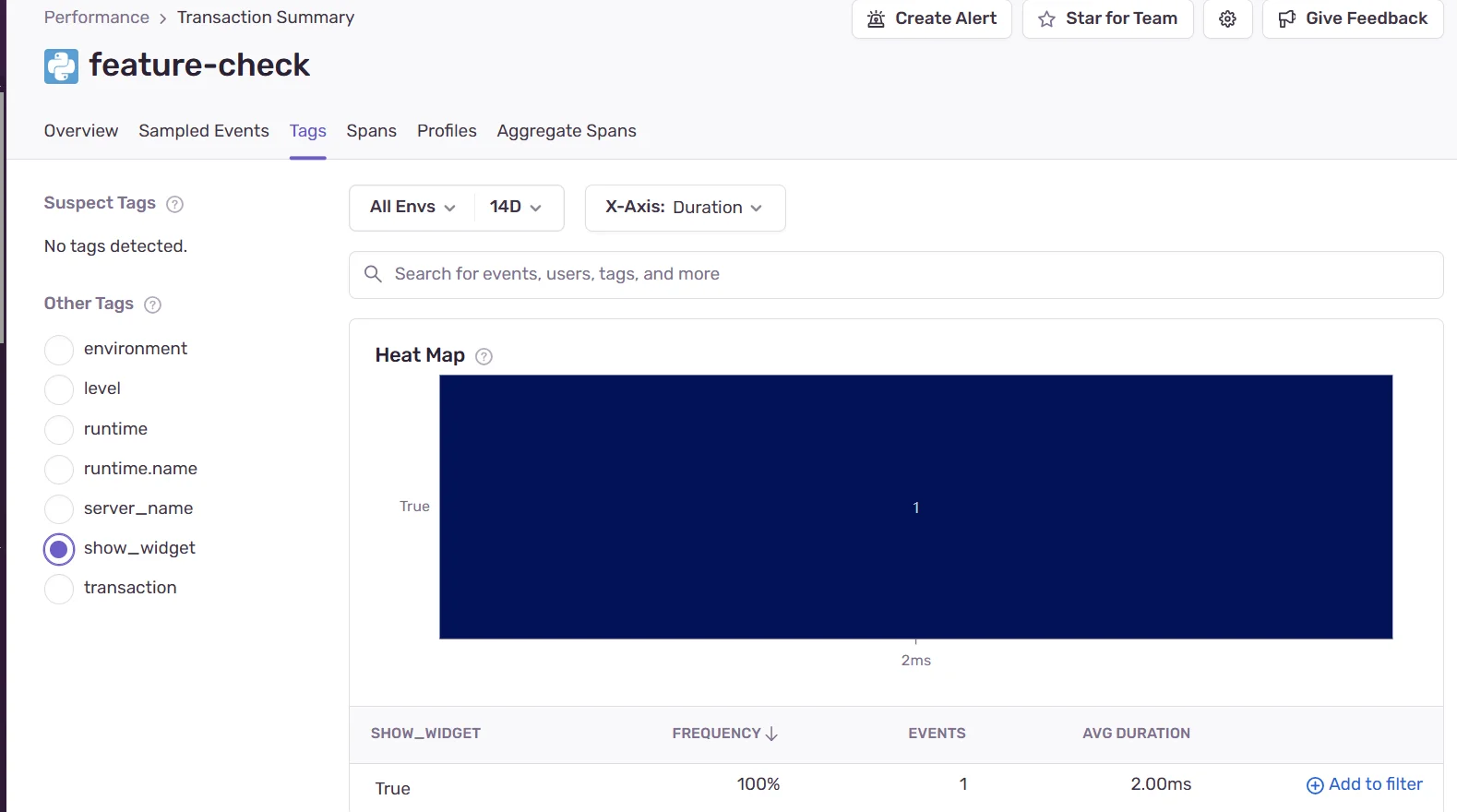
By using the feature flag in tags, you can answer questions like:
- "Is the issue happening only for users with the widget enabled?"
- "Are there performance issues when the widget is shown?"
- "Which combination of feature flags is causing this error?"
This allows you to isolate the root cause of an issue based on the specific features or configurations that are active.
Crash Reporting
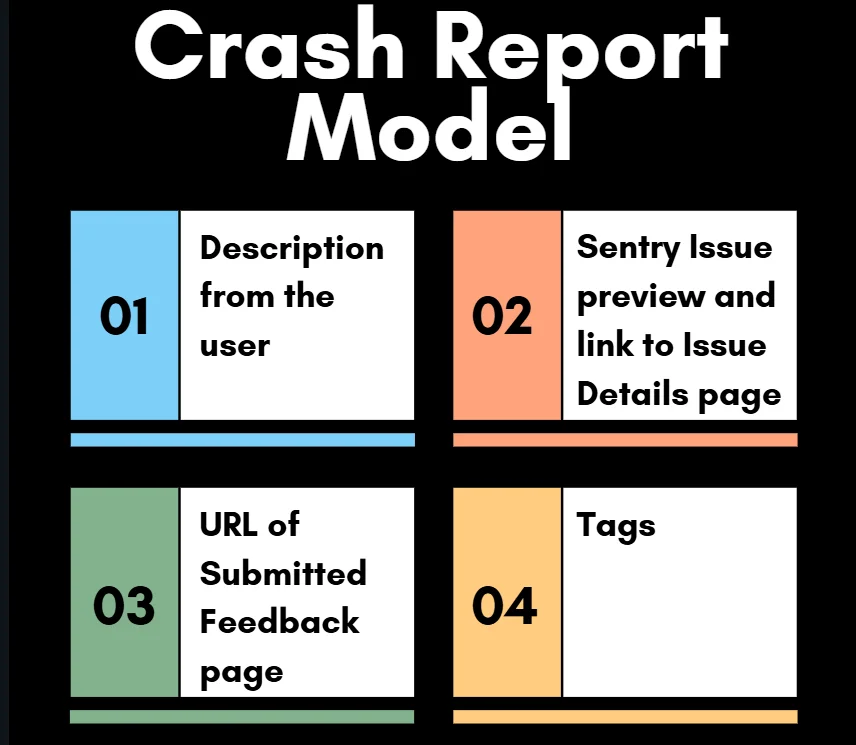
Sentry's Crash-Report Modal lets users submit feedback after they encounter errors. The modal collects the user's name, email address, and a description of what occurred, pairing this feedback with the original event for additional insights.
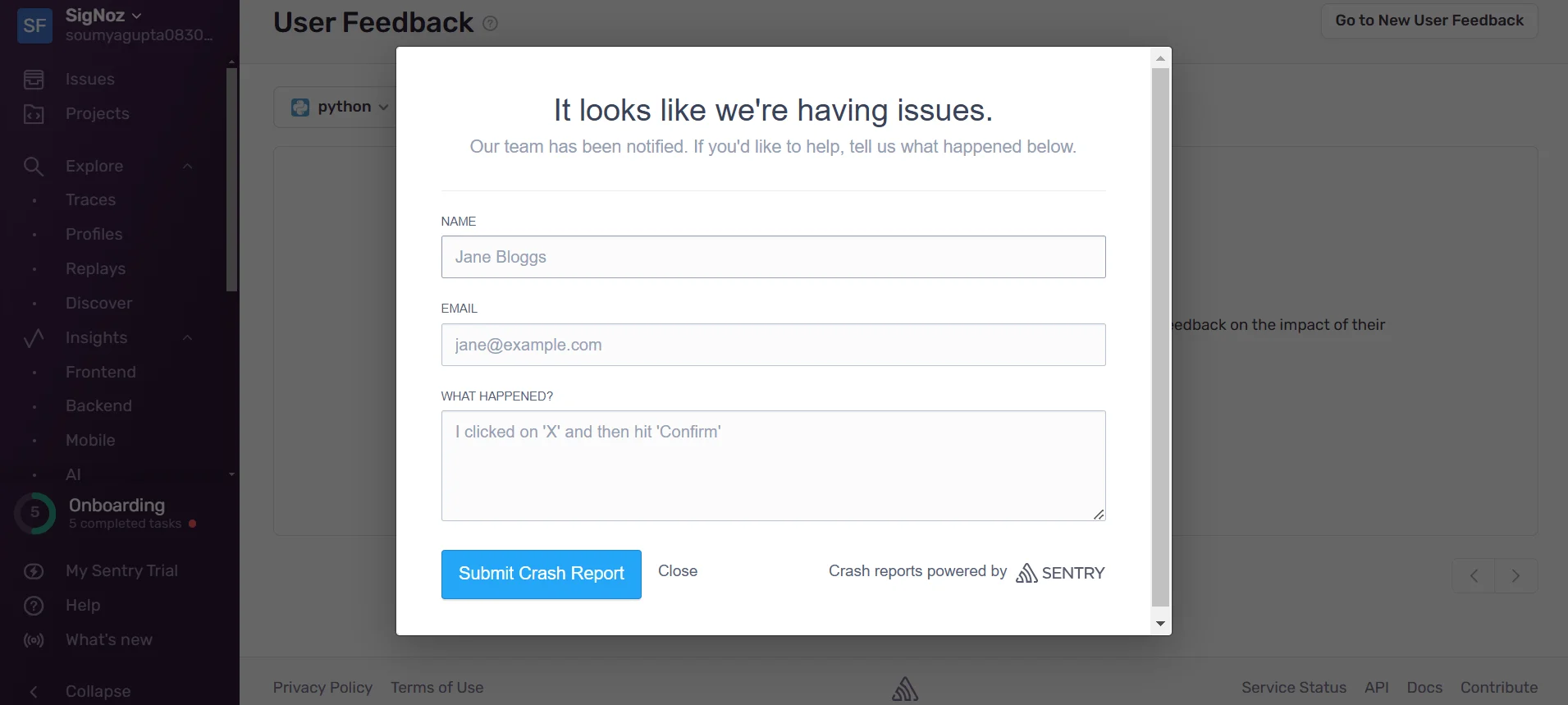
Performance Monitoring
While error tracking shows what went wrong, performance monitoring reveals why it happened and how it affects users. Sentry tracks slowdowns, measuring metrics like throughput and latency while mapping error impact across services. It also captures distributed traces to analyze service performance in depth.
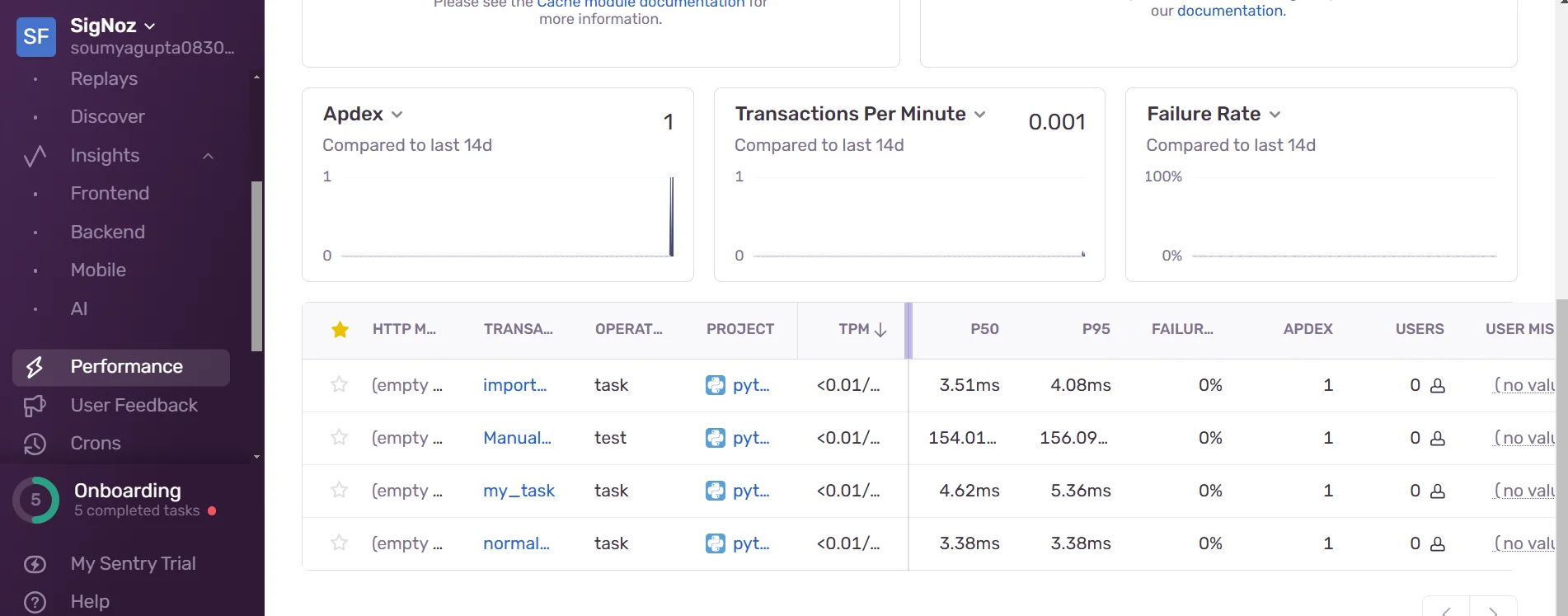
Using this information, you can trace issues back through services to identify poorly performing code, determine whether application performance is improving or degrading, and compare release performance over time.
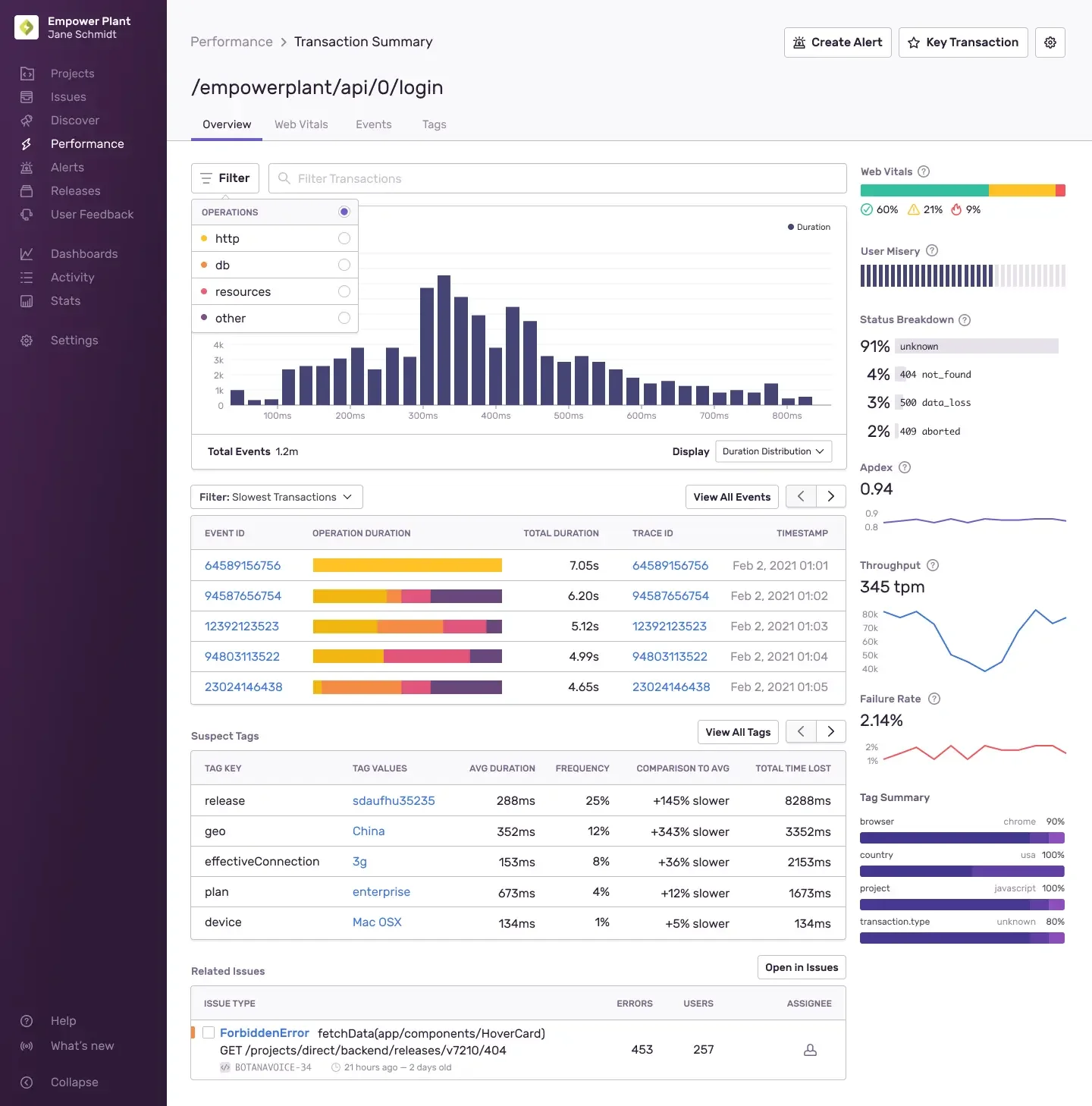
Tracing
In microservices architectures, distributed tracing stitches together the journey of a request as it moves through different parts of the system. This allows developers to:
- Identify which service or API call is causing latency
- Track dependencies between services
- Measure execution time across various parts of the stack
Sentry's SDKs automatically instrument application code to capture spans and transactions, which are fundamental to distributed tracing.
# Example of spans within a transaction
with start_transaction(op="task", name="my_task"):
with sentry_sdk.start_span(op="subtask", description="subtask_1"):
print("Subtask 1 is being executed...")
with sentry_sdk.start_span(op="subtask", description="subtask_2"):
print("Subtask 2 is being executed...")
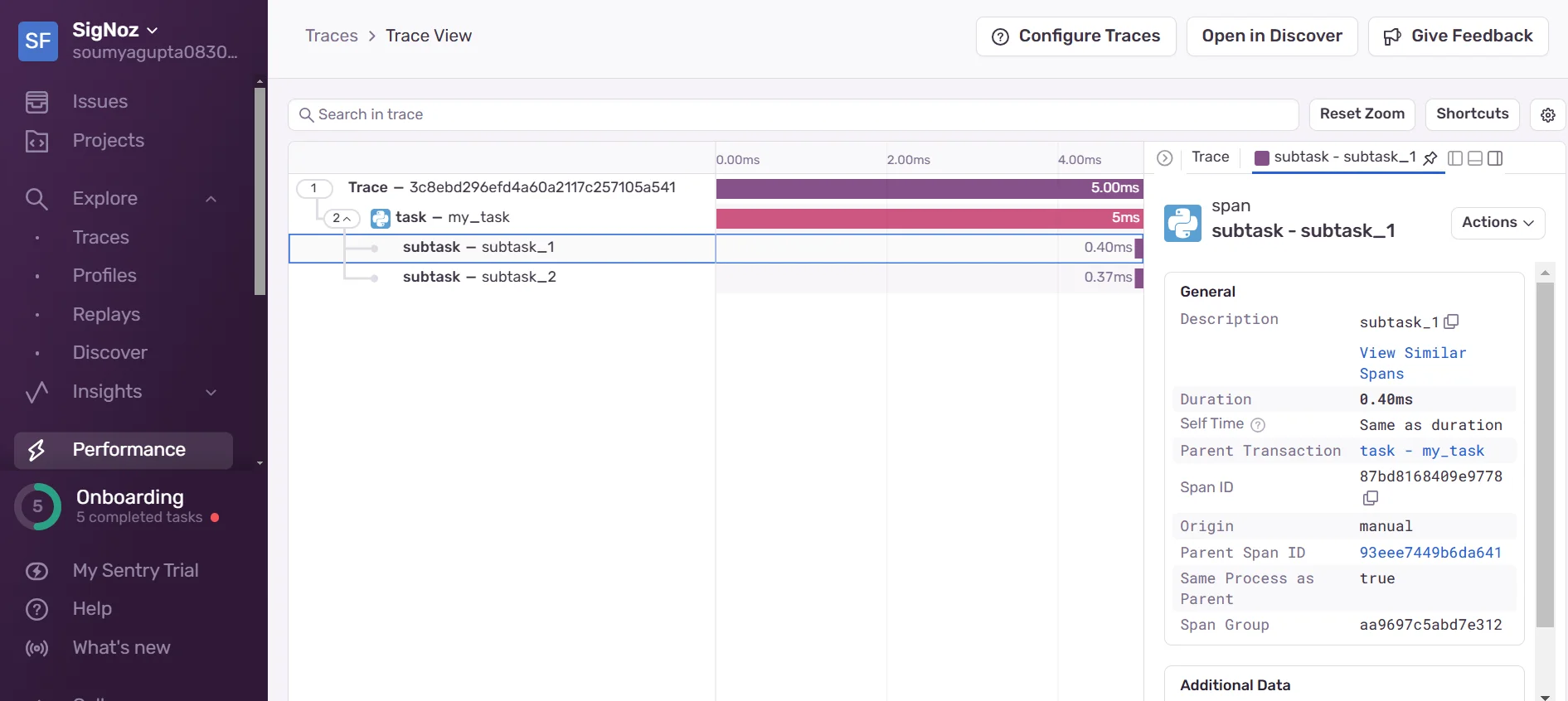
The Trace View allows you to drill down into a single trace to visualize transactions and spans, making debugging slow services and identifying bottlenecks faster and easier.
Release Tracking & Deployment Insights
- Track Issues by Release Version: Sentry links errors and performance problems to specific release versions.
- Automated Release Management: By integrating with version control and CI/CD pipelines, Sentry provides real-time visibility into deployment health.
- Commit Association for Debugging: Sentry's release tracking includes commit association, enabling teams to identify the exact commits and authors responsible for issues.
User Feedback
Sentry provides two primary methods for collecting user feedback:
- User Feedback Widget – Can be placed anywhere in your web application, allowing users to report issues even if the application hasn't crashed.
- Crash-Report Modal – Automatically appears when an application crashes, prompting users to submit feedback immediately.
Using Session Replay alongside the User Feedback Widget provides a visual representation of what the user experienced before submitting their feedback.
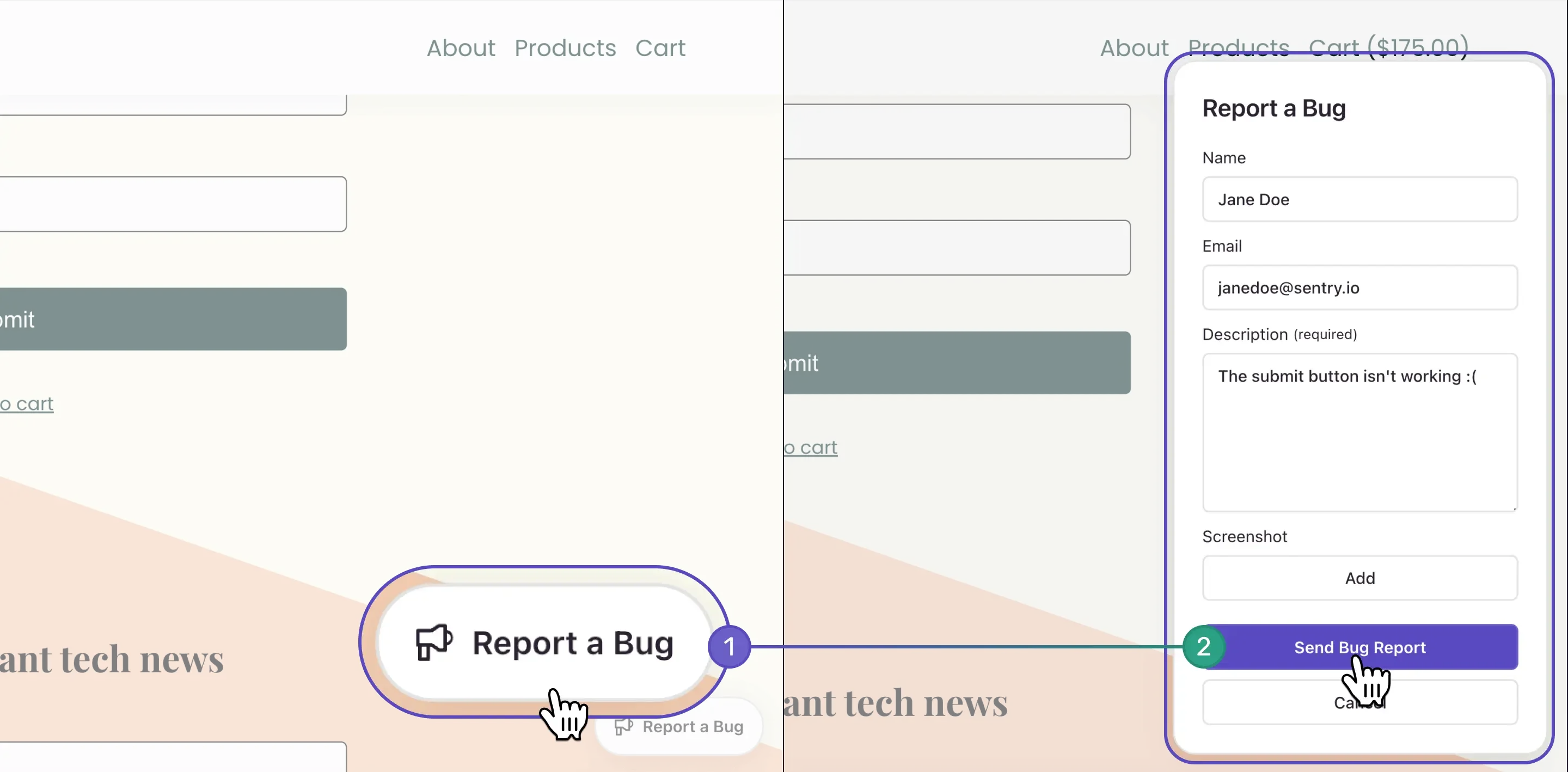
Compatibility and Integration
Sentry’s feedback collection features work with all browser-based applications, including Static websites, Single-page applications (SPAs) and Server-side-rendered applications
Sentry also supports a wide range of frameworks, such as Django, Spring, ASP.NET, Laravel, Express, and Rails, making it a versatile solution for developers across different ecosystems.
How the Sentry SDK Powers Feedback Collection
The Sentry SDK injects the User Feedback Widget directly into the client’s browser. This functionality is built into @sentry/browser and Sentry’s various browser framework SDKs, ensuring a seamless experience for both developers and end-users.
The Strengths of Sentry in Modern DevOps Practices
Sentry excels in several areas that are crucial for modern DevOps teams:
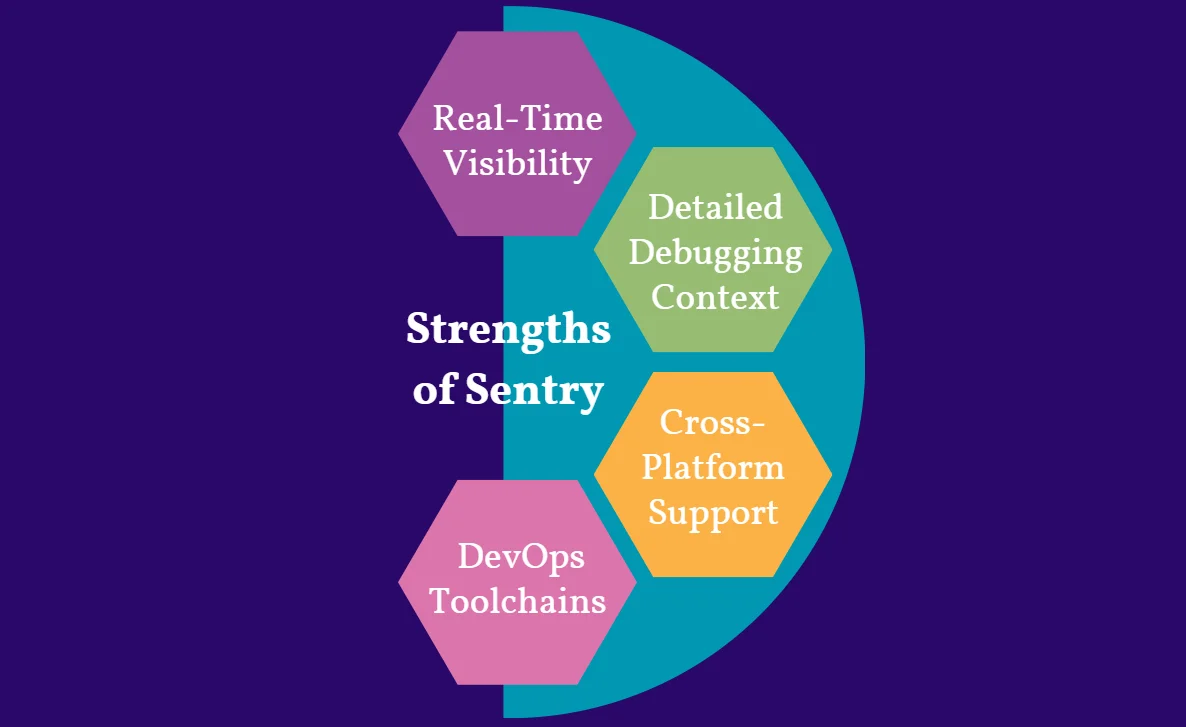
Real-Time Visibility
Sentry provides immediate error notifications, helping teams respond quickly to production issues and minimize mean time to detection (MTTD).
If you have Sentry's default issue alert i.e. Alert me on every new issue turned on for the project(s) with user feedback set up, then you should automatically get alerted every time new user feedback comes in via the User Feedback Widget.
If you don't have Sentry's default issue alert turned on, follow these steps to set up alerts for every new feedback:
Step 1: Create a New Alert Rule in Sentry.
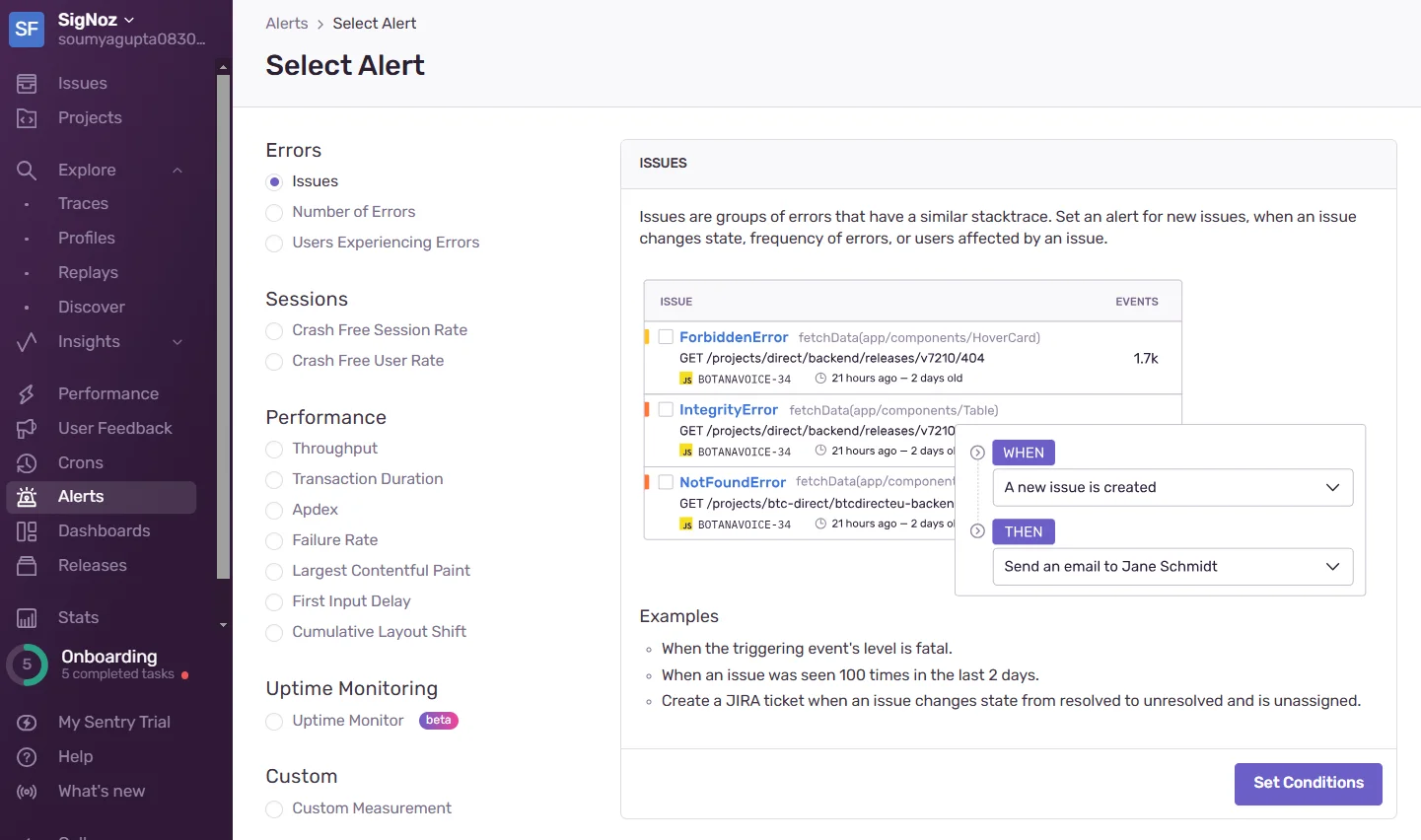
Step 2: Scroll to the "Set conditions" section, set the "IF" filter to your required condition, and choose which actions to perform in the “THEN” filter.
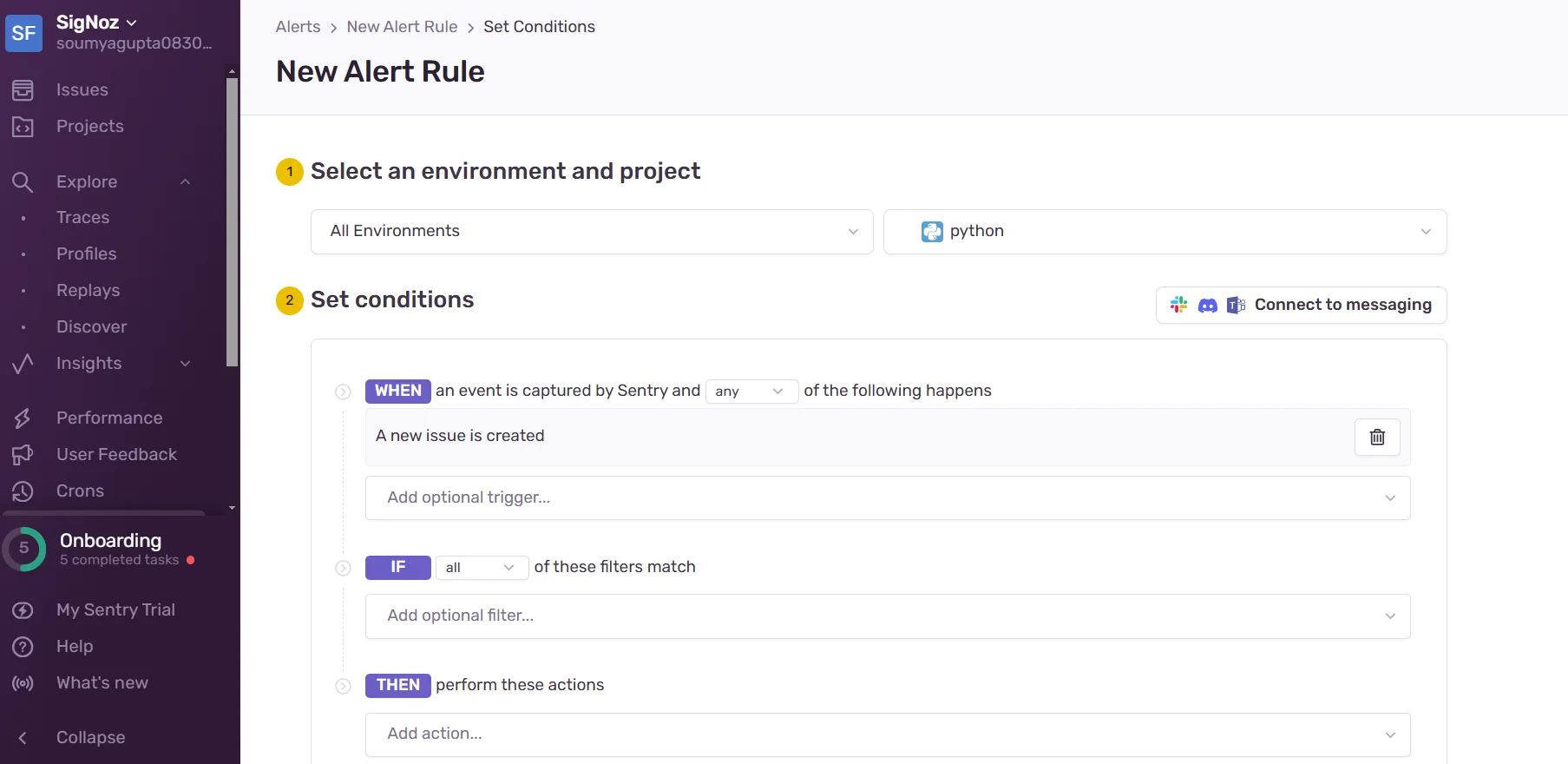
Step 3: Add an alert name and owner. To get notifications when crash-report feedback comes in, make sure to turn on Enable Crash Report Notifications in Settings > Projects > [Your Project Name] > User Feedback.
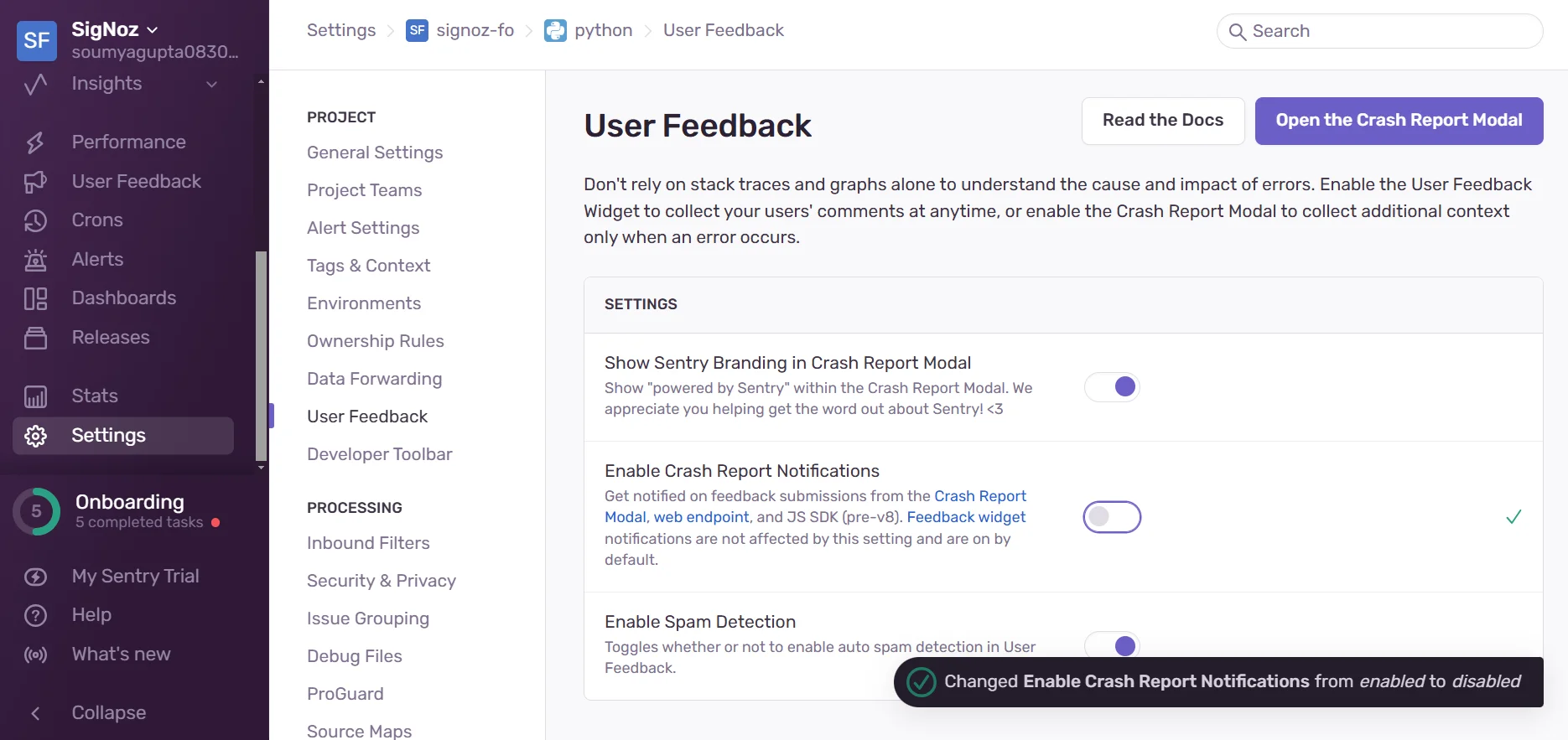
Detailed Debugging Context
Sentry provides two key debugging tools: breadcrumbs for tracking event sequences leading up to an error and trace context for linking transactions and errors across services.
sentry_sdk.add_breadcrumb(
category="task",
message="Starting transaction simulation",
level="info"
)
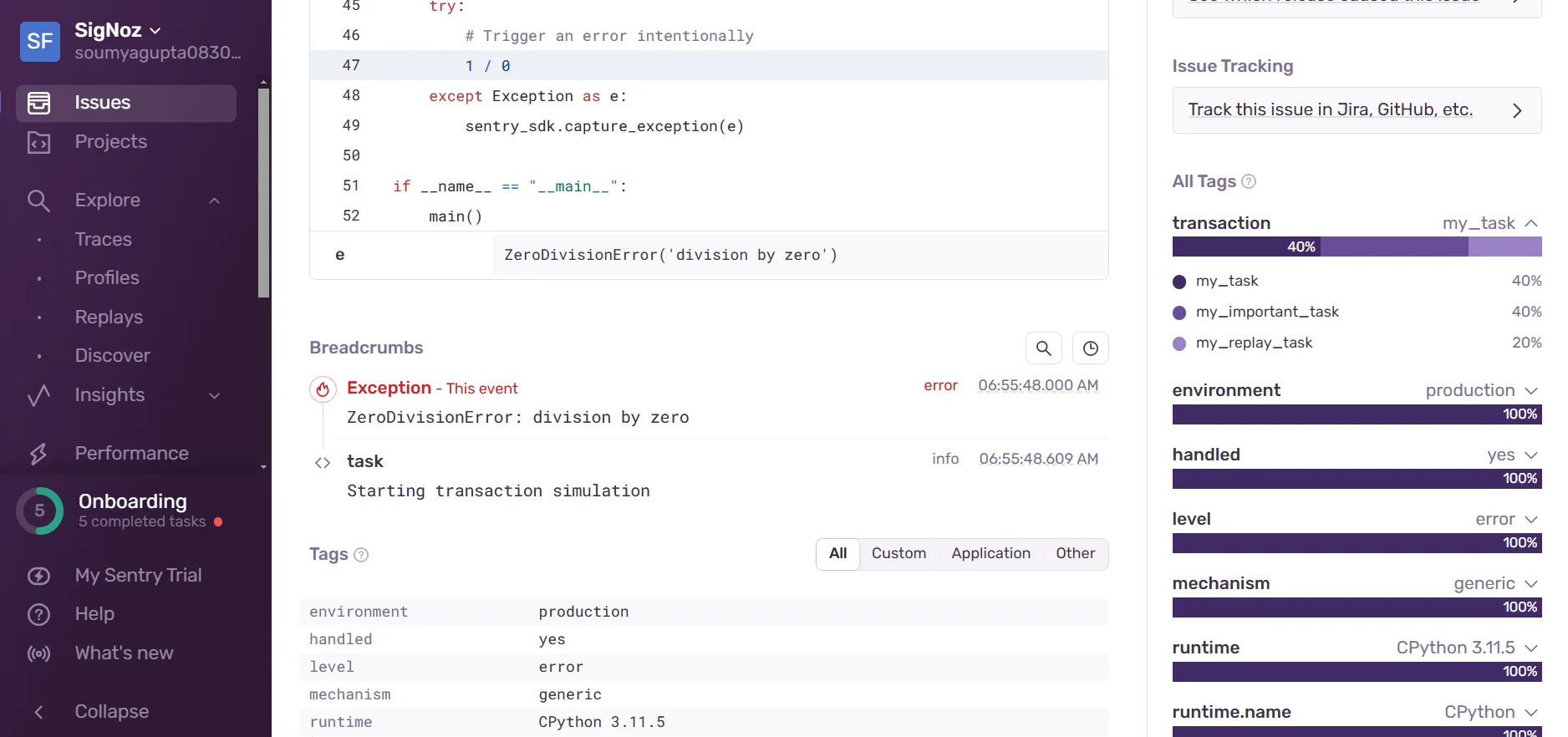
Trace context delivers crucial details that allow Sentry to link multiple transactions, spans, and errors into a unified trace.
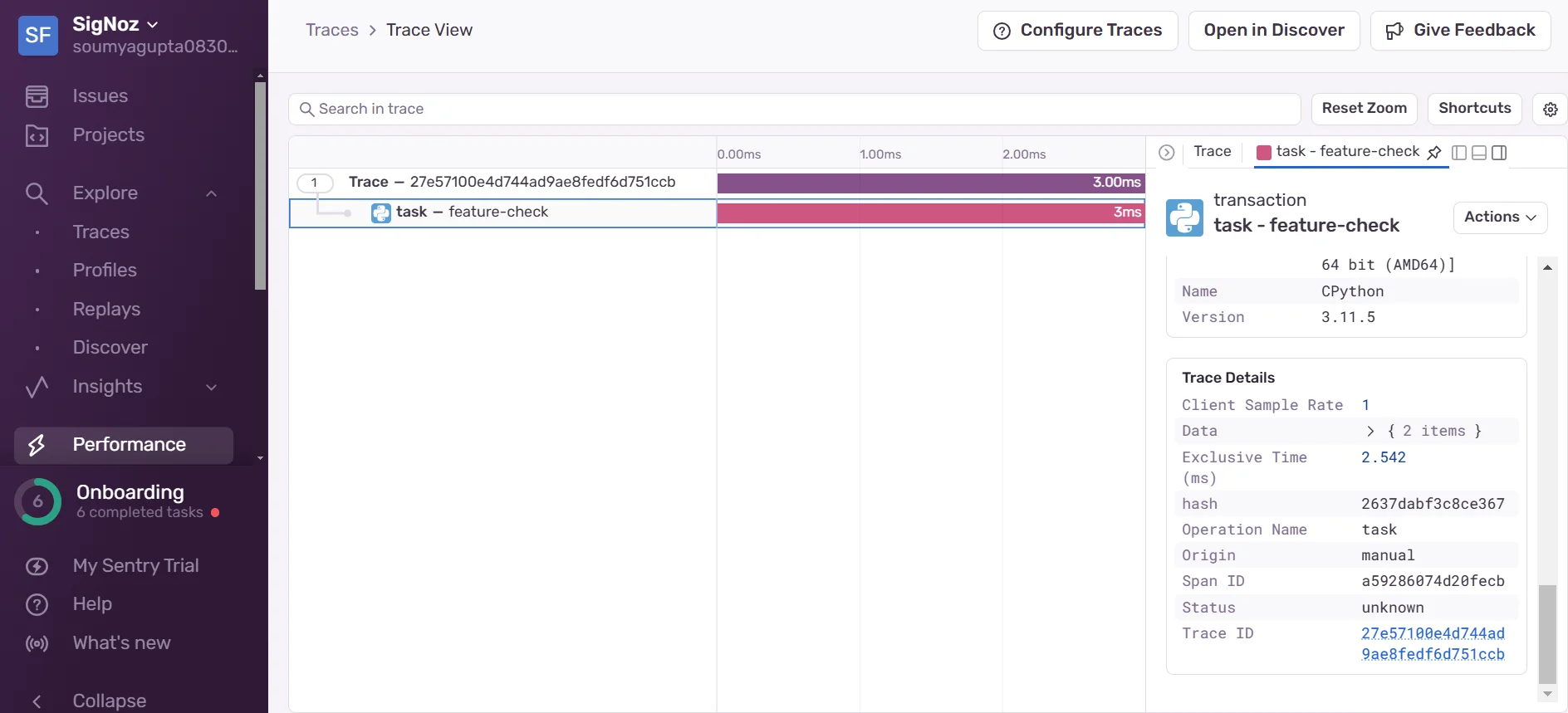
Cross-Platform Support
Sentry provides robust SDKs for both front-end frameworks and back-end languages, along with mobile support. With code-level observability, Sentry simplifies diagnosing issues while offering continuous insights into your application's code health.
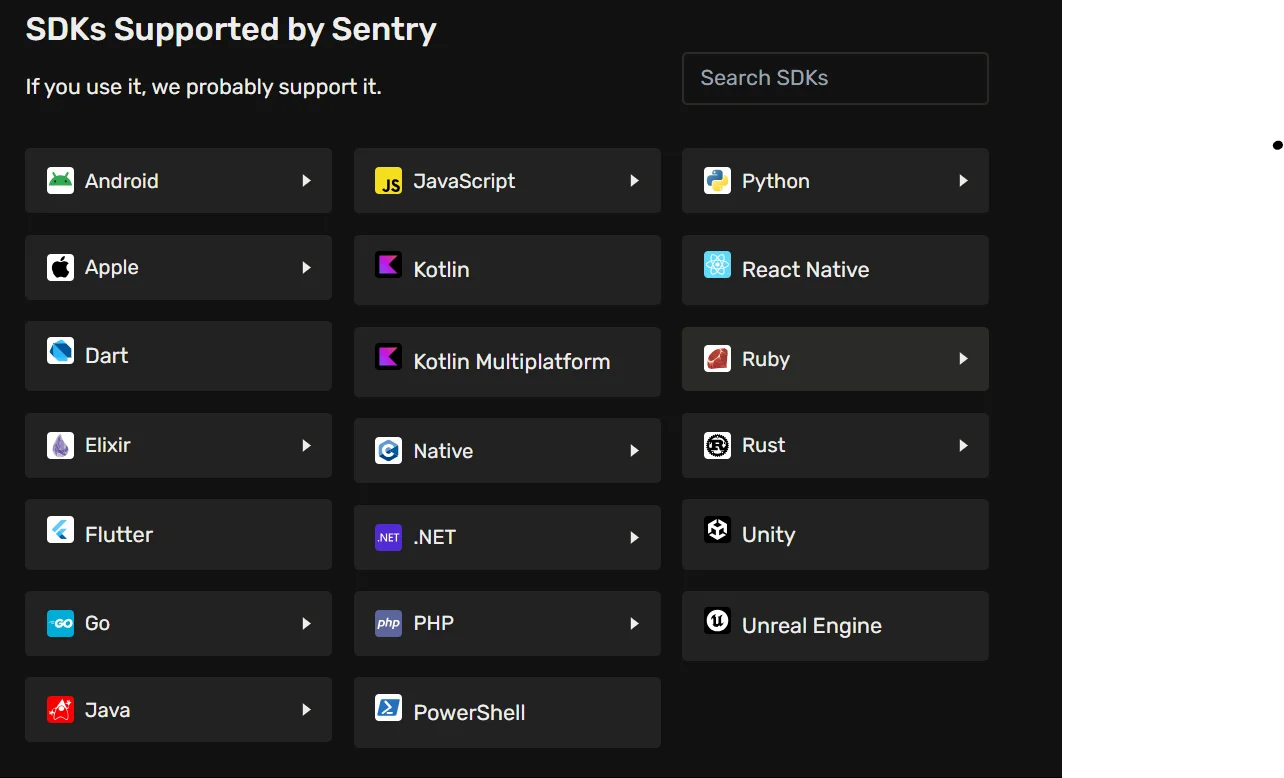
Integration with DevOps Toolchains
Sentry integrates seamlessly with Slack, Jira, GitHub, and CI/CD systems to accelerate error resolution and streamline development workflows. Key integration features include:
- Automated Issue Tracking & Resolution: Sentry can automatically create issues in Jira when critical errors occur and identify suspect commits.
- GitHub Integration: Enables stack trace linking, PR comments with issue details, and automatic issue resolution through commit references.
By integrating Sentry into your DevOps toolchain, you gain full visibility into code changes and their impact on application health, leading to faster debugging and more efficient collaboration.
Limitations of Sentry in Comprehensive Observability
While Sentry excels in error tracking and application performance monitoring, it has certain limitations in providing comprehensive observability across complex, distributed systems:
No Native Log Aggregation
Sentry lacks native log aggregation features, which are essential for analyzing large volumes of logs across various services. This necessitates the integration of dedicated log management solutions, such as the Elastic Stack or Loki, to achieve comprehensive log analysis and correlation
Primary Focus on Error Tracking and Application Performance
Sentry primarily concentrates on error tracking and application performance monitoring, without extending to infrastructure-level metrics like CPU, memory, or network usage. It also lacks built-in host monitoring capabilities for container orchestration platforms, such as Kubernetes node metrics, which are vital for maintaining the health and performance of the underlying infrastructure
Limited Distributed Tracing:
Sentry's distributed tracing capabilities are relatively basic compared to specialized tools like Jaeger or SigNoz. In intricate microservice architectures, this can hinder the ability to trace requests seamlessly across multiple services, making it challenging to diagnose performance bottlenecks and latency issues effectively.
Potential Over-Reliance on Client-Side Instrumentation
Implementing Sentry requires adding its SDKs to each service or client within the application. This approach can lead to potential gaps in monitoring if the instrumentation is incorrectly configured or omitted, resulting in missed critical data and incomplete observability
In short, Sentry’s limitations mean that by itself it provides an incomplete picture. It covers the application layer superbly but doesn’t give the birds-eye view of the entire system’s health. DevOps professionals often need to know not just that an error happened (which Sentry tells you), but also why – which might involve looking at database load, memory pressure, or a spike in user traffic, none of which Sentry tracks. Thus, Sentry is typically one piece of an observability suite, not the whole.
To achieve full-stack observability, it's often necessary to complement Sentry with other specialized tools that offer advanced distributed tracing, log aggregation, and infrastructure monitoring capabilities.
Comparing Sentry to Full-Stack Observability Solutions
Sentry is a robust application monitoring tool that excels in error tracking and performance monitoring. To understand its position within the observability landscape, let's compare it to full-stack observability solutions:
| Feature | Sentry | Full-Stack Solutions (SigNoz, New Relic, Datadog, etc.) |
|---|---|---|
| Scope | Focuses on application-level error tracking and performance monitoring. | Provides end-to-end monitoring, including infrastructure, logs, and APM. |
| Cost Model | Event-based pricing; cost-effective for small to mid-sized teams. | New Relic scales with data ingestion/users; advanced features can be costly. Datadog charges per host and feature usage; costs rise with infrastructure growth. SigNoz offers usage based pricing. |
| Metrics | Limited to application-level performance data. | Collects system-wide, container, and infrastructure metrics. |
| Logs | Captures exceptions but lacks full log management. | Provides centralized log aggregation and analysis. |
| Tracing | Effective for app-level traces but not ideal for large, distributed systems. | Full distributed tracing across services and infrastructure. |
| Extensibility | Can integrate with external tools like Prometheus, Grafana, or ELK for broader observability. | Built-in integrations for logs, traces, and metrics, reducing dependency on external tools. |
Exploring SigNoz as a Complementary Solution
SigNoz offers a unified observability platform that complements Sentry's capabilities, providing comprehensive monitoring across all three pillars of observability:
Key Features of SigNoz
Unified Telemetry: Collects metrics, traces, and logs in one platform, eliminating the need to switch between multiple tools when debugging issues
OpenTelemetry-Native: Built on the open-source OpenTelemetry standard, making it vendor-agnostic and compatible with various languages and frameworks
Advanced Distributed Tracing: Visualizes request flows across microservices with flamegraphs and Gantt charts, enabling deep performance analysis
Integrated Log Management: Correlates logs with traces for contextual debugging, offering capabilities similar to ELK stack but with better performance
Custom Dashboards: Creates visualization panels for metrics monitoring similar to Grafana+Prometheus, with the added benefit of direct links to related traces
Exception Tracking: Captures errors with stack traces and context, linking exceptions to the specific request traces where they occurred
Flexible Deployment: Available as both self-hosted (for compliance and cost control) and cloud-managed options
In summary, Sentry vs SigNoz features can be thought of as depth vs breadth. Sentry has a laser focus with rich features in error tracking (and some in performance), and lots of polish around those. SigNoz covers a wide range of monitoring needs with decent capability in each, and the gaps (like advanced error grouping or fancy UI elements) are steadily closing as the project develops.
SigNoz cloud is the easiest way to run SigNoz. Sign up for a free account and get 30 days of unlimited access to all features.
You can also install and self-host SigNoz yourself since it is open-source. With 24,000+ GitHub stars, open-source SigNoz is loved by developers. Find the instructions to self-host SigNoz.
Key Takeaways
- Sentry's Primary Strength: Excellent for error monitoring and performance insights at the application layer
- Augment with Complementary Tools: Combine with log management, metrics monitoring, and distributed tracing solutions (e.g., SigNoz) for true full-stack visibility
- DevOps Integration: Sentry can be woven into a continuous delivery pipeline, ChatOps, and incident management workflows
- Watch the Roadmap: Sentry's future developments could extend its role in the observability stack, but infrastructure-level monitoring will still likely require specialized tools
FAQs
Is Sentry sufficient for all observability needs in DevOps?
No. Sentry excels in error detection and performance tracing for your applications but lacks native capabilities for host-level metrics, log aggregation, and deep network insights. You'll typically need complementary tools for full-stack observability.
How does Sentry compare to full-stack observability platforms?
Sentry focuses on application errors and performance, while full-stack solutions like Datadog or New Relic include infrastructure monitoring, log management, and distributed tracing in a single platform. Sentry is often more cost-effective for error tracking but is less comprehensive overall.
Can Sentry be integrated with other monitoring and observability tools?
Absolutely. Sentry works well alongside log management (e.g., ELK Stack), metrics systems (e.g., Prometheus), and distributed tracing solutions (e.g., Jaeger, SigNoz). This combination yields a more holistic view of your system.
What are the key considerations when choosing between Sentry and alternative solutions?
Consider the following factors:
- Scope of Monitoring: Do you need host-level metrics, logs, or just error tracking?
- Cost and Scaling: Sentry pricing is based on events; high-traffic apps might become expensive
- Integration: Ensure the tool supports your language/framework stack and can integrate into your CI/CD and ChatOps workflows
- Open-Source vs. SaaS: If on-premises or compliance considerations matter, an open-source alternative like SigNoz may be more attractive
Sentry is an outstanding tool for application-level error tracking and performance insights. However, in modern DevOps environments—where distributed systems, container orchestration, and real-time data analysis are paramount—Sentry alone rarely suffices. By integrating Sentry with log aggregators, metrics dashboards, and robust tracing solutions, teams can achieve the full-spectrum observability needed to ship reliable software in complex, fast-paced ecosystems.
